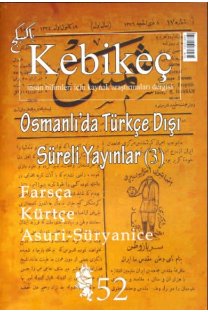Çin işi Japon işi,acep bu kimin işi? Fatsa'dan Nagoya'ya bir göç hikayesinin gölgesindeki kadınlar
Bu çalışmanın temel amacı, 90'lı - yıllardan itibaren kocalarının Fatsa'dan (Türkiye) Nagoya'ya (Japonya) göç etmesinin ardından kadınların iktidar, güç ve cinsiyet rolleri açısından değişen hayatlarını daha iyi anlamaktır. Çalışma, özellikle kadınların hane içindeki kontrolünün artıp artmadığını, aile ile ilgili konularda karar verme süreçlerindeki rollerinin güçlenip güçlenmediğini, göçmen eşi olarak toplumdaki statülerinin değişip değişmediğini ve eğer bu soruların cevabı olumlu ise bu güçlenmenin/değişikliğin hangi dereceye kadar yaşandığını odağa almaktadır. Çalışma sorusu, aynı zamanda, toplum genelinde böyle bir göçün kadınların yaşamındaki kakçı değişiklikleri yansıtan geniş perspektifli resmin daha iyi anlamlandırılabilmesine de imkân tanımaktadır.
Chinese or Japanese, whose work is this? women behind a migration story from Fatsa to Nagoya
The aim of this study is to understand how women's lives have changed in terms authority, power and gender roles after their husbands' migration from Fatsa (Turkey) to Nagoya (Japan) since the beginning of the 1990s. The study mainly focuses on the changes authority of women within the household, the role of women in decision-making process'" concerning family issues, and their social status as wives of migrants in their hometown Tb research question also provides an opportunity to shed light on a further point to grasp the meaning of the whole picture of the society reflecting permanent changes in women's lives aftc' migration.
___
Abadan-Unat, N. vd. (1975). Göç ve Gelişme: Uluslararası işçi göçünün Boğa^lıyan ilçesindeki et küm ürerine bir inceleme. Ankara: Ajans-Türk Matbaacılık Sanayi.Abadan-Unat, N. (1977). Implications of Migration on Emancipation and Pseudo-Emancipation of Turkish Women. International Migration Review, 11(1), 31-57.
Abadan-Unat, N. (2006). Bitmeyen Göç: Konuk İşçilikten Ulus-Otesi Yurttaşlığa. İstanbul: İstanbul Bilgi Üniversitesi Yayınları.
Boehm, D. A. (2008). "Now I Am a Man and a Woman!": Gendered Moves and Migrations in a Transnational Mexican Community. Tatin American Perspectives, 158(35), 16-30.
Cohen, J. (2001). Transnational Migration in Rural Oaxaca, Mexico: Dependency, Development, and the Household. American Anthropologist, 103(4), 954-967
Coşkun, Y. ve Türkyılmaz, A.S. (2009). Analyzing the Aspects of International Migration in Turkey by Using 2000 Census Results. In İçduygu, A. ve Kirişçi, K., I .and of Diverse Migrations: Challenges of Emigration and Immigration in Turkey (s. 365-440). İstanbul: Istanbul Bilgi Üniversitesi Yayınları.
Desai, S. ve Banerji, M. (2008). Negotiated identities: Male migration and left-behind wives in India. Journal Of Population Research, 25, 337-355.
Drotbohm, H. (2010). Gossip and social control across the seas: targeting gender, resource inequalities and support in Cape Verdean transnational families. African and Black Diaspora: An InternationalJournai, 3(1), 51-68.
İçduygu, A. ve Sirkeci, İ. (1998). Changing Dynamics of the Migratory Regime between Turkey and Arab Countries. The Turkish Journal of Population Studies, 20, 3-16.
Engel, B.A. (1986). The woman's side: Male out-migration and the family economy in Kostroma province. S lavic Revieiv, 45(2), 257-271.
Fidan, F. ve Fidecioğlu, A. (2010). Türkiye'den Almanya'ya Göç Sürecinde Geride Kalan Kadınlar: Alamanyalı Beylerin Fedakar Eşleri. Yardım ve Dayanışma Dergisi) 1, s.29-39. http://www.sydgm.gov.tr/site_kutuphane/upload/kutuphane/1281344270rl769.Yrd._Doc._Dr ._Fatma_FIDAN_Dr._Ahmet_FIDECIOGLU.pdf adresinden alıntılanmıştır.
Gordon E. (1981). An analysis of the impact of labor migration on£'the lives of women in Lesotho. Journal of Development Studies, 17(3), 59-76.
Hadi, A. (1999). Overseas migration and the well-being of those left behind in rural communities 0f Bangladesh. Asia-Pacific Population Journal, 14(1), 43-58.
İçduygu, A., Sirkeci, I. ve Muradoğlu, G. (2001). Socio-Economic Development and International Migration: A Turkish Study. International Migration, 39(4), 39-61.
Kadıoğlu, A. (1994). Impact of Migration Experiences on Gender Roles: Findings of a Field Research in Turkey. International Migration, 32(4), pp.533-560.
Kalaycioğlu, S., Çelik, K. ve Beşpınar, F.M. (2010). "Gitmek mi Zor Kalmak mı?": Avrupa'ya Erkek Göçü ve Geride Kalan Kadının Gözünden Göç Deneyimi. Journal of Faculty letters, 27(1), s.123-146.
Kıray, M. (1976). The Family of Immigrant Worker. In Abadan-Unat, N. (Ed.), Turkish workers in Europe 1960-1975: a socio-economic reappraisal (s.210-234). Leiden: Brill
Koç, İ. ve Onan, I. (2004). International Migrants' Remittances and Welfare Status of the Left-Behind Families in Turkey. International Migration Review,38(1), 78-112.
Mahler, S. J. (2001). Transnational Relationships: The Struggle to Communicate Across Borders. Identities, 7(4), 583-619.
Malkin, V. (2004). "We Go to Get Ahead": Gender and Status in Two Mexican Migrant Communities. Latin American Perspectives, 138, 31(5), 75-99.
Mynitti, C. (1984). Yemeni Workers Abroad: The Impact on Women. MERIP Reports, 124, Women and Labor Migration, 11-16.
Nguyen, L., Yeoh, B.S.A. ve Toyota, M. (2006). Migration and the Weil-Being of the 'Left Behind' in Asia. Asian Population Studies, 2(1), 37-44.
Osella, F ve Osella, C. (2000). Migration, Money and Masculinity in Kerala. Journal of Royal Anthropological Institute, 6, 117-133.
Pribilsky, J. (2004). 'Aprendemos a convivir': conjugal relations co-parenting, and family life among Ecuadorian transnational migrants in New York City and the Ecuadorian Andes. Global Networks, 4(3), 313-334.
Reeder, L. (2001). Conflict across the Atlantic: Women, Family and Mass Male Migration in Sicily, 188- 1920. International Review of Social History, 46, 371-391.
Taylor, E. (1984). Egyptian Migration and Peasant Wives. MERIP Reports, 124, Women and Labor Migration, 3-10.
Yabuki, T.S., Agadjanian, V., Sevoyan, A. (2010). Husbands' labor migration and wives autonomy, Mozambique 2000-2006. Population Studies, 64(3), 293-306.
- ISSN: 1300-2864
- Yayın Aralığı: Yılda 2 Sayı
- Başlangıç: 1995
- Yayıncı: Mehtap Yüksel
Sayıdaki Diğer Makaleler
Çin işi Japon işi,acep bu kimin işi? Fatsa'dan Nagoya'ya bir göç hikayesinin gölgesindeki kadınlar
Muhafazakar modren medeniyet projesinin kadın mimarı: Halide Edip Adıvar
Ezberin inşası: milli mücadele ve erken Cumhuriyet dönemi basınında Kürt meselesi
Yunan ayaklanması sırasında Girit Resmo'da müsadere ve müzayedelere dair bir inceleme
A. Nükhet ADIYEKE, NURİ ADIYEKE
Fransız şarkiyatçı C. Hauart Anadolu yollarında neler yedi?
Mektebden en samimi çiftçi selamları
Kitle siyaseti ve siyasi afişler: Bolşevikler örneği
Coğrafyanın azizliği ya da sınırboyunda nahiye olmak: Vakıf nahiyesi (1879-1914)
